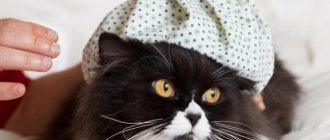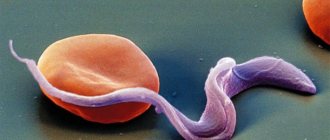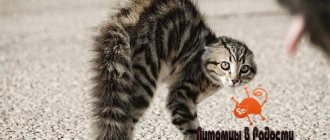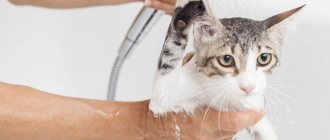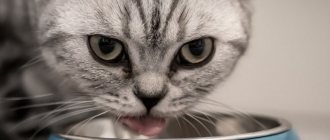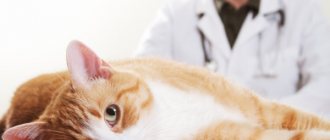Independent in nature, British Shorthair cats have strong bones, a rounded muzzle and large, expressive eyes. And their “plush” coat has become one of the many advantages of the breed. With proper care, the “British” can live 15 years or even more. But neither domestic cats nor those with access to free walks in the fresh air are 100% protected from diseases. Therefore, every owner should know what characteristics his pet has, and what should be taken as warning signs and signals for an unscheduled visit to the veterinarian.
- Diseases of the breed
- Symptoms
- Genetic diseases
- What are the most common diseases in British cats?
- Conjunctivitis
- Parasites
- Gastrointestinal diseases
Main symptoms of the disease
British cats, like any other breed, are susceptible to various diseases. Even if your animal is constantly in an apartment or house and does not go outside, you should not think that the disease will bypass it. During the day you communicate closely with various people, travel on public transport, visit places with large crowds of people, where there are a lot of pathogens, and you bring all this home on your shoes and clothes.
Cats come near your things, you can pet them without washing your hands, and as a result, the pet may catch some kind of virus.
© shutterstock
The most common symptoms of British cat disease that can help you determine that something is wrong with your pet:
- refusal of food;
- redness of the eyes;
- hair loss;
- breathing problems;
- cough;
- vomit;
- diarrhea or lack of bowel movements;
- decrease in body temperature.
Breed-specific diseases
The health of the British people, if not excellent, is very good. There are rarely problems with them, but all sorts of things still happen. There are not many ailments that affect these animals, but it will be useful for everyone to know about them.
Viral
Diseases of viral etiology are not uncommon in animals.
Most often it makes itself known:
- Panleukopenia . This disease is also called feline distemper. The disease is dangerous because it lowers the number of leukocytes and also affects the gastrointestinal tract. The disease can occur in pets of all ages; it responds well to treatment, but you should not let the disease progress, because it can cost the purr’s life.
- Leukemia . This is oncology. The disease affects the furry circulatory system. Unlike people, the disease does not occur on its own in animals; you can become infected from sick animals, as well as through food. Considering that the disease passes in a latent form, the pathology does not manifest itself for a long time. Unfortunately, the disease cannot be cured, but by choosing the right treatment tactics, it will be possible to extend the Briton’s life by 5-7 years.
Endocrine system disorders
When talking about endocrine diseases, only diabetes mellitus comes to mind. This is an ailment that does not allow the cells of the body to be fully nourished. It is not difficult to notice the problem, because the animal begins to quickly gain weight or, on the contrary, lose it.
In addition, you can pay attention to symptoms such as:
- smell of acetone from the mouth;
- thirst;
- weakness;
- oppression.
Timely treatment will make it possible to restore the pet’s condition.
Gastrointestinal tract
Diseases affect British cats extremely rarely. However, if they are diagnosed, then most often the problem lies in the gastrointestinal tract.
Animals encounter:
- Feline constipation. Trouble makes itself felt at any age. A caring owner will not miss the moment when the pet begins to sit on the potty for a long time and push hard, trying to poop. There can be a great variety of causes for the disease; only a doctor can determine the exact cause. In addition to problems with defecation, you can notice depression of the fluffy, refusal to feed, and apathy.
- Colitis. We are talking about inflammation in the large intestine. It is in this part that fluid is absorbed and feces are formed. If inflammation occurs in the intestine, then motility is impaired, therefore, stool changes its structure, and in addition, blood or mucus may be observed in it.
- Coronavirus enteritis. This disease is contagious and infectious in nature. The problem arises due to inflammatory processes occurring in the large intestine. In a mild form, the disease responds well to treatment, which cannot be said about a severe one. However, it is much easier to notice the second one - the animal’s digestion process is disrupted, and there are also signs of a cold.
- Gastritis. Many people believe that gastritis is not a pathology at all, but a temporary disorder, but this is not so. Of course, this is not a common disease in British cats, but if you don’t pay attention to it, it will lead to serious consequences. Experiencing unpleasant sensations, the pet will refuse food, and it may begin to vomit undigested food debris. This will lead to poor digestibility of food, as well as general poor health of the animal. In this case, feeding the British plays an important role, which should be balanced, but at the same time nutritious.
Symptoms
If you notice any other symptoms listed above, immediately contact your nearest veterinary clinic.
Refusal to eat is the first sign that something is wrong with your cat. The presence of a more serious disease may be indicated by vomiting or diarrhea . Some owners are mistaken in thinking that if you touch a cat’s nose and it turns out to be cold, then the animal is quite healthy. This is absolutely not true. Temperature should be measured with a thermometer specifically designed for animals.
A normal temperature is considered to be between thirty-eight and thirty-nine degrees; if the reading is higher, then your pet is seriously ill, and care not provided in time can lead to serious consequences.
An increase in body temperature may mean that a British Shorthair has serious diseases such as pneumonia or a disorder of the central nervous system.
Parasites - fleas, ticks and worms
Worms in small quantities do not cause any particular problems, but they can be eliminated through preventive measures. Vet pharmacies offer a lot of suspensions and tablets for cats and cats against helminths.
Prevention is carried out every 3-4 months. Intoxication due to helminthic infestation leads to sad consequences. It manifests itself in bloating, poor coat appearance, inflammation of the eyes, thinness, and diarrhea. Sometimes parasites appear in feces.
Fleas are poisoned with drops, sprays, special collars or shampoos. The latter option is short-lived, so it is better to use long-acting drugs.
British cats can develop allergies from collars. Drops are used once every 3 months. They are also designed to eliminate subcutaneous mites.
What to pay attention to
You shouldn't judge the health of the British people just by a cold nose. At elevated body temperatures, the nose of cats may be moist and cold; the eyes of a natural color may show no signs of clouding or redness. Therefore, first of all, you need to pay attention to changes in the behavior, habits, habits and general condition of the British cat.
At the beginning of the disease, animals can begin to heal themselves. If you live in a rural area or in a private house, then a Briton may eat certain grass and lick wounds.
To make sure your pet is in good health, you can take the temperature (this must be done rectally). If you detect any violations, in order to provide first aid, keep a pipette, a bandage and any wound disinfectant on hand. Medicines intended for humans are strictly prohibited from being given to the British. It is better to immediately seek help from a veterinarian and get qualified instructions regarding treatment (do not forget to take your vaccination record with you).
© shutterstock
Ringworm
This is a fungal disease. It is characterized by complete baldness of the skin. When a rash appears, the cat begins to experience discomfort and scratches the affected areas. To diagnose the disease, microscopy of the fur is performed, and the affected areas are also examined under a Wood's lamp. In this case, problem areas will glow light green.
Previously, this disease of British cats was considered incurable. But now there is a whole range of drugs that will help overcome the disease. The therapy uses antifungal ointments, immune-supporting vaccines, and special creams. A disease such as ringworm is dangerous for humans. Therefore, the owner of a cat with this diagnosis should take precautions.
Let's look at each type of disease separately.
British diseases linked to genetics
British Shorthairs have a peculiarity that experts encountered after developing this breed of cats - this is the presence of two blood groups A and B at the same time. Externally, this heredity of the disease does not manifest itself in any way in the behavior or appearance of the cat. You can encounter it when offspring are born.
If a cat and a she-cat that mate have different blood types, then the kittens are born with two different blood types. In the first days, no symptoms will indicate that the kitten is sick. Only if the baby does not die in the first three days, it means he was not susceptible to this genetic disease.
Death occurs as a result of the fact that antibodies against someone else's blood type are transferred to the baby through the cat's milk.
There is a special test to avoid this problem, but it is not yet available in our country.
Special diseases of the British
From the large number of diseases to which pets are susceptible, some specific diseases of British cats can be identified:
- Viral.
- Associated with the endocrine system.
- Neurological in nature.
- Rectum.
- Gastrointestinal tract.
- Brain.
Viral diseases include panleukopenia and leukemia
© shutterstock
Panleukopenia (popularly known as plague) is a disease that affects the stomach of the British and reduces the level of white blood cells in the blood. Since white blood cells are responsible for the body’s ability to fight various types of diseases, their decrease leads to the inability to fully perform their function. Animals can become infected through feces from a sick relative.
Small kittens are the least able to cope with the disease, because the fragile body is not yet able to fight and when the body temperature rises, the body becomes exhausted and dies.
Leukemia is a cancerous disease in which the circulatory system is affected and malignant neoplasms are formed. A domestic cat can become infected from a sick pet, poor-quality food, poorly disinfected instruments in a veterinary clinic, or from insects.
The disease can develop and remain asymptomatic for several months .
It is detected by a constant decrease in the cat’s appetite, the inability to bear offspring, inactivity, and the functioning of the cardiovascular muscle is disrupted. The disease cannot be cured, but only a more or less normal state can be maintained by using certain medications.
SMALL REVISIONS
When it comes to cat health and thinking ahead, we cannot ignore the topic of blood type.
Today there are three types of blood groups:
- A (dominant);
- AB (transitional, extremely rare);
- B (recessive).
Often, ordinary veterinarians and “therapists” don’t even know about this, so you should go to breeders and genetic centers that conduct this kind of examination.
Why do you need to know your cat's blood type? If your pet needs:
- blood transfusion (may be needed spontaneously). Your city may not have such surveys or they may take a lot of time. In this case, there is a high probability of losing the animal.
- participate in breeding. For example, if a cat has blood type B, and a cat has blood type A, then all the offspring will die (at best, their tails will dry out). As a result of a conflict between these blood groups, born kittens, feeding on mother's milk, die after 2-3 days. Reason: the walls of the intestines and stomach of kittens in newborn age are usually very vulnerable. With mother's colostrum, kittens receive useful substances, but in this case, antibodies kill babies.
Other diseases
Disturbances in the functioning of the endocrine system of a British person may be indicated by developing obesity or, conversely, exhaustion, excessive drinking, and a specific smell in the oral cavity. As a result, diabetes mellitus develops. The cat will need to be injected with insulin throughout its life and maintained on a strict diet.
A disease associated with a disorder of the nervous system is epilepsy. If a Briton falls ill with this disease, the cat will most likely have to be euthanized - treatment is useless.
British breed cats are prone to diseases associated with the gastrointestinal tract. They should not be overfed or given poorly processed or stale food.
The most common is urolithiasis in British cats. The cat has blood in its urine, the animal is in pain, the color of the urine has changed, you notice that the pet is licking the urethra more often - contact your veterinarian immediately. The appearance of sand and stones in the genitourinary system can be fatal.
© shutterstock
Heart problems
British cats are predisposed to hypertrophic cardiomyopathy. The work of the heart is disrupted, the volume of blood in it decreases due to an increase in the thickness of the wall of the heart ventricle.
An ultrasound examination and examination by a veterinarian are required. At the beginning of the development of the disease, it has virtually no effect on the cat’s condition. In some individuals it does not appear throughout their lives.
Complications are dangerous - cardiovascular failure, which is identified by shortness of breath, wheezing, fatigue, and the depressed state of the pet.
General diseases
British shorthairs also suffer from diseases that occur in both their relatives of the Scottish breed and ordinary cats.
- Respiratory diseases.
- Worms.
- Diseases of the eyes and teeth.
- Claw diseases.
These types of illnesses are the least dangerous and can be easily avoided by providing your Brit with proper care.
To avoid problems with the eyes, wash them daily with chamomile infusion or ordinary boiled water.
The oral cavity must be kept clean, and the change in smell and condition of the cat’s teeth must be monitored.
Leukemia
This is a cancerous disease. The disease affects the circulatory system. A cat can become infected from a sick cat. The disease develops asymptomatically over a fairly long period of time. Gradually, the animal's appetite decreases and it becomes inactive. The disease is practically incurable. Expensive foreign drugs are used as therapy.
Puberty in the British
Active puberty of British breed cats begins at the age of 8-10 months. It is at this age that cats begin to walk and ask for a cat.
It is recommended to breed British cats after 1 year, when the body is fully formed to the required degree.
A British cat is in heat
On average, the first heat in cats of the British breed begins at the age of 7-9 months. However, it is impossible to determine the exact period; it all depends on the individual genetics of the British woman, the conditions of her keeping and feeding. In addition, premature estrus can be caused by an adult uncastrated cat with its “calls” if it is somewhere nearby.
The duration of one heat is 8-10 days, the first – 4-5 days. The break between them usually lasts about 20 days, but again it all depends on the hormonal level of the animal.
You can determine when a British cat is in heat by the following signs:
- frequent loud meowing and purring;
- changes in gait (the cat coquettishly bends its knees);
- friction against various objects and the owner’s legs;
- rolling on the floor;
- a sharp change in character;
- demand for increased attention to one’s person.
So the British woman starts asking for a cat. You can help your cat in one of the following ways:
- Let go for a walk;
- Give sedative drops;
- Sterilize.
Mating of British breed cats
Crossbreeding of British cats is recommended at the age of 1 to 2 years. The first mating of a British breed cat up to a year old can lead to an interrupted birth process or even death, and cats can lose the ability to reproduce by the age of 2 years. Therefore, it is recommended to skip the first 2 heats of a British female. However, mating should not be delayed too much - after 2 years, the cat may become so aggressive that it will not allow the cat to come near it.
In most cases, the cat is brought to the cat on the 2nd day of estrus and left for 2-3 days. Remember that officially the British cat breed does not allow mating with other breeds, so if you want purebred kittens, breed only straight-eared British cats.
If your cat doesn't get pregnant the first time, don't despair, just wait for the next heat and try again.
Vitamins for British cat breeds
Note! In order for a Briton to always look healthy, his diet must contain special vitamin supplements.
Water-soluble vitamins, such as Kitzel, are especially suitable for British cats. Biotin, calcium and other minerals contained in these vitamins help form strong bones, healthy teeth, as well as improve shedding cycles, prevent matting of your pet's fur, especially in long-haired British cats, and body tremors. Vitamins that produce “8 in 1” have also proven themselves well. However, they should be used only as needed - an excessive amount of drugs can lead to a disease such as hypervitaminosis.



